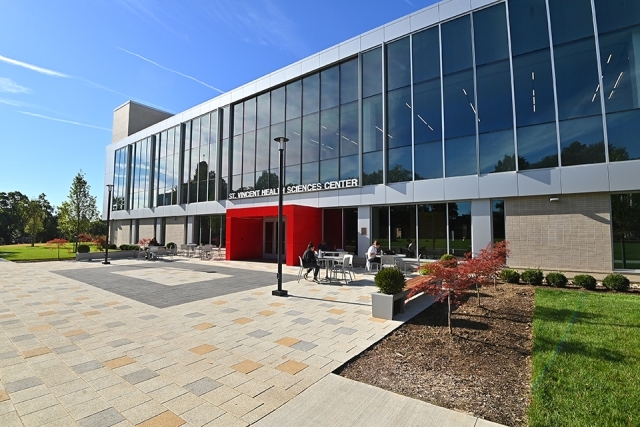

St. Vincent Health Sciences Center
Building for St. John's Future
The state-of-the-art St. Vincent Health Sciences Center supports and houses the University’s health sciences programs. The opening of the $106 million facility marks another milestone in St. John’s commitment to fostering service, innovation, and academic excellence.
The new, energy-efficient building features active learning classrooms, laboratories, simulation facilities, office space, collaborative spaces, and outdoor terraces. Constructed to be environmentally friendly, sustainability features include geothermal heating, rooftop solar panels, and high-performance windows designed to reduce thermal loss.
Work on the 70,000-square-foot facility began in early 2022. It opened for classes in Fall 2024. It is home to students in the University’s Nursing, Radiologic Sciences, and Physician Assistant programs.
“The opening of the St. Vincent Health Sciences Center represents our unwavering commitment to providing our students with the best possible resources and facilities,” said Rev. Brian J. Shanley, O.P., President of St. John’s.
A building designed not just for today’s conditions, but for tomorrow’s unimagined needs
The facility is designed around an interior, multistory, social common space. This “living room” acts as the heart of the academic program and promotes both planned and chance interactions between students and faculty. The Dorothea and Nickolas Davatzes Atrium welcomes visitors as they enter from the Great Lawn. Outside, eye-catching plazas and terraces tie directly into the campus walkway system.

Get to Know the New St. Vincent Health Sciences Center
The new building features a holistic and scalable approach to sustainability. It accommodates a series of both campus and New York City sustainability initiatives and contributes to the carbon reduction efforts of the entire University.
Square Feet
Opened for Classes

Enhancing the Queens Campus
The facility is situated between the residential and academic areas of St. John’s 102-acre campus and positively shapes and define the physical space of the Great Lawn. As such, its architectural character is quieter with respect to the more classical nature of St. Augustine Hall and St. John Hall.
Key Features of the Center’s Teaching and Learning Environment
Virtual-reality (VR) technology offers health-care providers, students, and patients an engaging and effective way to learn about the human body. Users can upload any 3D scan and render it in virtual or augmented reality within seconds.
State-of-the-art classrooms and lecture halls provide an optimal learning environment for students whose clinical skills training is observed through one-way glass and remotely via audiovisual capture systems.
